|
The music for the sung services is of traditional character, and is provided by a small group of singers from the congregation. Apart from the hymns and plainchant, a motet is performed at every sung mass. Singers are always welcome to join us.
|
|
|
|
A feature of the musical life at S. Silas is the professional performances, several times each year, of masses and motets for voices and instruments. Although largely drawn from the music of Haydn, Mozart and Schubert, it has recently been extended to include the Magnificat by Pergolesi and the Requiems of Fauré and Saint-Saëns.
|
|
|
|
The church is fortunate in possessing an excellent acoustic, and a spacious gallery with ample room for singers and instrumentalists to be close to the organ console.
|
|
|
|
When the church was built J C Bishop and Son built an organ on the west wall of the church, with tubular pneumatic action from a console placed on the floor of the gallery beneath and facing east.
|
|
|
|
By the 1990s this organ had become effectively unplayable, and in view of its limitations it was decided to investigate the possibilities of substantial rebuilding or replacement. The organ had no stops above 4ft pitch and, although there were some attractive voices, had little balance between departments and individual registers.
|
|
|
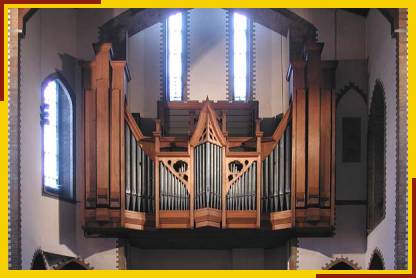
Pipe work and case of Bishop Organ |
|
|
After much thought and investigation, it was decided to ask Copeman Hart to provide an instrument, which would be adequate for the occasions when the church is full and at the same time would have the necessary voices to enrich the liturgy and for choral accompaniment. This was installed in 1994, being built and voiced according to the organist's specification. It has proved itself well suited to these tasks and copes particularly well with French music, including that of the baroque, and is a good instrument for the music of Bach. The case and pipework of the redundant organ was mounted on the west wall and used to conceal the loud speakers of the Copeman Hart organ.
|
|
|
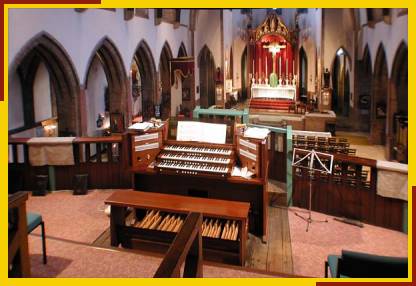
Copeman Hart console with view of Church |
|
|
Grand Orgue
|
Montre 16
Montre 8
Flûte 8
Bourdon 8
Prestant 4
Flûte 4
Fourniture IV
Cymbale III
Bombarde 16
Trompette 8
Clairon 4
|
|
|
Positif
|
Bourdon 8
Gambe 8
Prestant 4
Flûte 4
Nazard 22/3
Quarte 2
Tierce 13/5
Cymbale IV
Basson 16
Cromorne 8
Tremblant
|
|
|
Récit
|
Montre 8
Flûte harmonique 8
Cor de nuit 8
Gambe 8
Voix céleste 8
Flûte harmonique 4
Octavin 2
Cornet V
Trompette 8
Hautbois 8
Voix humaine 8
Clairon 4
Tremblant
|
|
|
Pédale
|
Soubasse 32
Flûte 16
Soubasse 16
Flûte 8
Violoncelle 8
Flûte 4
Bombarde 32
Bombarde 16
Trompette 8
Clairon 4
|
|
S. Silas is also fortunate in possessing a Grade II star chamber organ which is a rare example of an instrument by Jonas Ley, which was built in 1772 and is substantially in its original condition. It stands on the south side of the nave, in its fine mahogany case with gilded front pipes. It retains the original short octave in the bass and its original winding system although there is also an electric blower. The organ restorers Manders say some of the pipes are even centuries older than that.
The first known owner was organ builder Percy Daniels, from whose home in Somerset it was transferred to All Saints', Notting Hill, in 1940, to be shifted again to S. Silas' when All Saints' was blitzed.
Compiled from 'Ham and High' September 19th 1980 |
|
|
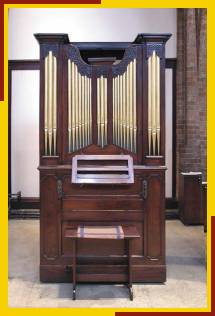 Chamber Organ |
Stop Diapason Base (to Middle C)
Stop Diapason Treble (from middle C#)
Open Diapason (from tenor G - grooved below to Stop Diapason Base)
Principle
Fifteenth
Sexquartan Base (to Middle C)
Cornet Treble (from middle C#)
Compass: Short Octave GG, AA, C, no C# - e3 |
|
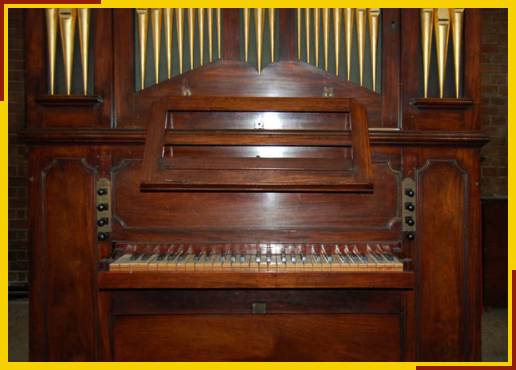
Chamber Organ Clavier |
|
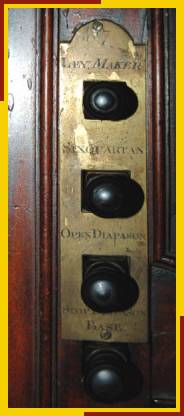 Left jamb |
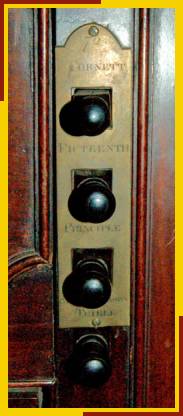 Right jamb |
|
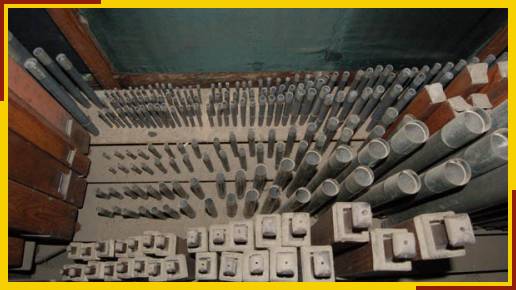
Chamber organ pipes |
|
|
The Organ at Holy Trinity
|
|
|
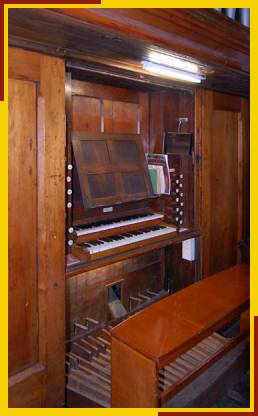
Organ console |
|
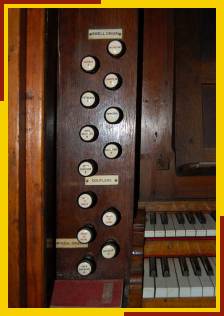 Swell stops |
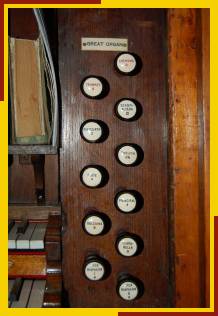 Great stops |
|
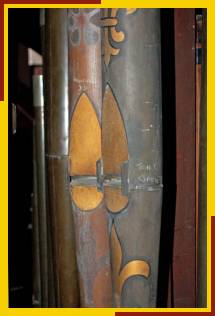 Decorated pipes |
|
|
|
Great Organ
|
Open Diapason I 8
Open Diapason II 8
Clarabella 8
Dulciana 8
Principal 4
Flute 4 to c
Twelfth 22/3
Fifteenth 2
Sesquialtera III
Cremona 8 to c
Trumpet 8
|
|
|
Swell Organ
|
Open Diapason 8 stopped bass, from c shared with the Gamba
Salicional 8 stopped bass, from c shared with the Open Diapason
Voix Céleste 8 to c
Principal 4
Fifteenth 2
Hautboy 8
Cornopean 8
Tremulant
|
|
|
Pedal
|
Open Diapason 16 wood
Bourdon 16
Usual couplers |
|
|
Compass: Manuals C - e3: Pedals C to d1 (with a modern concave and radiating pedal board of full compass, the top three notes acting only on the couplers)
|
|
|
|
It has no name plate except that of Bishop & Sons who were responsible for the most recent restoration. In the Illustrated London News of 19 October 1850 it was reported: "The organ, placed on one side of the chancel, is of very sweet and powerful tone. It was erected by Messrs. Bevington and Sons of Greek-street, Soho." This is a Grade II organ in recognition of it being an interesting instrument containing substantial material by Bevington c 1850.
|
|
|
|
It seems likely that this is that instrument in virtually its original condition. It would therefore be one of the first "German compass" instruments in the country. Although in need of restoration, it is still in regular use and the tone continues to be "very sweet" and adequate for the building if not powerful by present standards.
|
|
|
|
Redundant Organ at S. Silas
|
|
|
|
Details taken from:- (Monthly Paper, November 1914, page 8) - Description of the New Organ
|
|
|
|
Great Organ, Compass CC to a, 58 notes
Open Diapason 8ft 58 pipes
Clarabella 8ft 58 pipes
Dulciana 8ft 58 pipes
Principal 4ft 58 pipes
Wald Flute 4ft 58 pipes
Trompette Harmonique 8ft 58 pipes
|
Swell Organ, Compass CC to a, 58 notes
Lieblich Bourdon 16ft 58 pipes
Violin Diapason 8ft 58 pipes
Lieblich Gedact 8ft 58 pipes
Vox Angelica 8ft 58 pipes
Voix Celestes 8ft 49 pipes
Geigen Principal 4ft 58 pipes
Oboe 8ft 58 pipes
|
|
|
Pedal Organ, Compass CC to f, 30 notes
Open Diapason 16ft 30 pipes
Sub Bass 16ft 30 pipes
Lieblich Bourbon 16ft 30 pipes
|
Couplers, etc.
Swell to Great
Swell Octave
Swell Sub Octave
Swell Unison off
Swell to Pedal
Great to Pedal
|
|
|
Combination Pistons to Great and Pedal Organs
Combination Pistons to Swell Organ
Great to Pedal on and off by Pedal
Tremulant to Swell
Separate console with stop keys. Electric power blowing.
|
|
|
|
Organists of S. Silas 1892 - 2010
|
|
|
|
Miss Vincent 1892 of 5 Sackville Street, W
|
|
|
|
Mr. E. A. Payne 1895 - 1896 then became Choirmaster.
|
|
|
|
Joseph Brereton 1897 - 1898
|
|
|
|
Mr. A. W. Gibbs 1909 - 1910
|
|
|
|
Mr. H. C. Holzapfel Oct 1913 - Dec 1916
|
|
|
|
Fr. A. J. Clark 1917 Both priest and organist.
|
|
|
|
Edward James Bennett Nov 1917 - Sept 1918 - then called up.
Formerly Organist of St. Chad's, Haggerston.
|
|
|
|
Monthly Paper, Nov - Dec 1918, page 12 - List of Church Officials, Servers and others on Service -Organists- H. C. Holzapfel, A. W. Gibbs, E. J. Bennett.
|
|
|
|
Mr. S. Cockeram Oct 1918 - Dec 1919
Formerly Organist at St. Faith's, Stoke Newington.
|
|
|
|
Edward James Bennett Jan 1920 - Dec 1923 (Died April 26th 1924, aged 34)
Obituary - Bi-Monthly Paper, July - August 1924, pages 10-11.
(His wife gave the picture of the Madonna and Child which hangs above the gallery steps to the church in his memory).
|
|
|
|
Mr. Frank W. Harding Dec 1923 - Oct 1926
Music teacher and Organist.
Director of Music at Golders Green Crematorium for about 25 years. Died 1971.
|
|
|
|
Mr. P. A. Tapp Nov - Dec 1927
|
|
|
|
Harold Walter James Rabson 1928 - 1969
(He was born near S. Silas in 1900, baptised confirmed and married here. He was a choir boy when the present church was consecrated and in due course became an assistant organist. He was a skilled musician and especially fond of plainchant and liturgical music. He wrote a number of mass settings, hymns and motets for this and other churches. He also taught composition at Morley College in London. He was also a man of prayer, using the rosary every day of his life. The statue of S. John Vianney is dedicated to his memory.)
Played the parts of a shepherd, Judas, and S. Silas in Benjamin Boulter's Mystery Plays.
He inherited a choir of men and boys from Mr. Bennett but at the onset of the Second World War the children of the Parish were evacuated and the choir lost its boys. After this there were only two or three ladies and men.
|
|
|
|
David Fysh 1969-
Friend of Fr. Cobb.
25 years - Director of Music, Wycliffe College Junior School, Stonehouse, Gloucestershire.
Later became the Revd. David Fysh - 1995 Parish Priest at S. Mary's, West Walton, Wisbech, Cambridgeshire.
|
|
|
Peter St. John Stokes Dec 1992 - June 2013
Peter St.John Stokes was born in Yorkshire in 1944. He started playing the organ at school, and from the age of sixteen had lessons with Dr Francis Jackson, organist of York Minster. He went to Trinity College of Music, London, where he studied organ, singing and orchestral conducting as well as composition with Dr Arnold Cooke. He also has a degree in French and a MMus in historical musicology from Kings College, London. As a former pupil of Naji Hakim, organist of La Trinité, Paris, he takes a particular interest in improvisation.
He taught, first in London, and then for twenty-one years as Director of Music at Loreto College, St Albans. During this time he continued to play the organ and to be involved in choral conducting, having given many concerts both in this country and abroad.
Previous organist positions include St Giles-the-Fields, London and Dunstable Priory. Currently working as a freelance musician and teacher, since 1992 he has been organist of St Silas, Kentish Town. |
|
|
|
Peter Dutton: September 2016 – present day
Peter teaches at Christ’s Hospital, Horsham, and was
appointed Director of Music at S. Silas in September 2016. At the same time,
John Bachelor was appointed as Assistant Director of Music. Between them, they
have further developed the musical repertoire at S. Silas and established a
regular choir of four professional singers who sing at the 11.00am Mass every
Sunday and maintain the highest standards of performance to assist with the
Liturgy. This choir is further enhanced by other singers and musicians for
festivals. The Assistant Director normally plays for the 9.30am Mass at Holy
Trinity, where there is also a regular choir, members of the congregation, who
perform at the Sunday Mass once a month . On Sunday evenings there is a Said
Mass with music, followed by Benediction, for which one of our organists plays.
|
|
|
Saint Silas Church, Kentish Town, London, NW5.
|